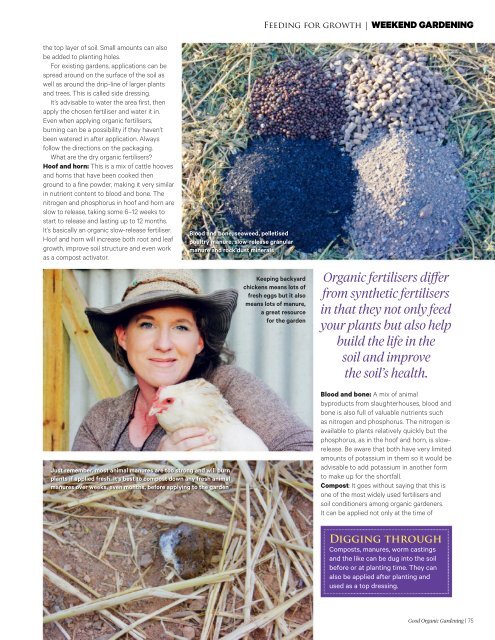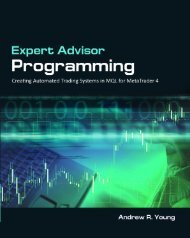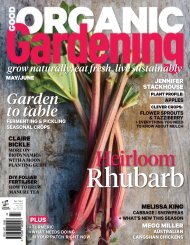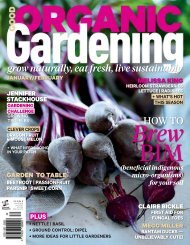5. Good Organic Gardening - September-October 2016 AvxHome.in
5. Good Organic Gardening - September-October 2016 AvxHome.in
5. Good Organic Gardening - September-October 2016 AvxHome.in
Create successful ePaper yourself
Turn your PDF publications into a flip-book with our unique Google optimized e-Paper software.
Feed<strong>in</strong>g for growth | WEEKEND GARDENING<br />
the top layer of soil. Small amounts can also<br />
be added to plant<strong>in</strong>g holes.<br />
For exist<strong>in</strong>g gardens, applications can be<br />
spread around on the surface of the soil as<br />
well as around the drip-l<strong>in</strong>e of larger plants<br />
and trees. This is called side dress<strong>in</strong>g.<br />
It’s advisable to water the area first, then<br />
apply the chosen fertiliser and water it <strong>in</strong>.<br />
Even when apply<strong>in</strong>g organic fertilisers,<br />
burn<strong>in</strong>g can be a possibility if they haven’t<br />
been watered <strong>in</strong> after application. Always<br />
follow the directions on the packag<strong>in</strong>g.<br />
What are the dry organic fertilisers?<br />
Hoof and horn: This is a mix of cattle hooves<br />
and horns that have been cooked then<br />
ground to a f<strong>in</strong>e powder, mak<strong>in</strong>g it very similar<br />
<strong>in</strong> nutrient content to blood and bone. The<br />
nitrogen and phosphorus <strong>in</strong> hoof and horn are<br />
slow to release, tak<strong>in</strong>g some 6–12 weeks to<br />
start to release and last<strong>in</strong>g up to 12 months.<br />
It’s basically an organic slow-release fertiliser.<br />
Hoof and horn will <strong>in</strong>crease both root and leaf<br />
growth, improve soil structure and even work<br />
as a compost activator.<br />
Blood and bone, seaweed, pelletised<br />
poultry manure, slow-release granular<br />
manure and rock dust m<strong>in</strong>erals<br />
Keep<strong>in</strong>g backyard<br />
chickens means lots of<br />
fresh eggs but it also<br />
means lots of manure,<br />
a great resource<br />
for the garden<br />
<strong>Organic</strong> fertilisers differ<br />
from synthetic fertilisers<br />
<strong>in</strong> that they not only feed<br />
your plants but also help<br />
build the life <strong>in</strong> the<br />
soil and improve<br />
the soil’s health.<br />
Just remember, most animal manures are too strong and will burn<br />
plants if applied fresh. It’s best to compost down any fresh animal<br />
manures over weeks, even months, before apply<strong>in</strong>g to the garden<br />
Blood and bone: A mix of animal<br />
byproducts from slaughterhouses, blood and<br />
bone is also full of valuable nutrients such<br />
as nitrogen and phosphorus. The nitrogen is<br />
available to plants relatively quickly but the<br />
phosphorus, as <strong>in</strong> the hoof and horn, is slowrelease.<br />
Be aware that both have very limited<br />
amounts of potassium <strong>in</strong> them so it would be<br />
advisable to add potassium <strong>in</strong> another form<br />
to make up for the shortfall.<br />
Compost: It goes without say<strong>in</strong>g that this is<br />
one of the most widely used fertilisers and<br />
soil conditioners among organic gardeners.<br />
It can be applied not only at the time of<br />
Digg<strong>in</strong>g through<br />
Composts, manures, worm cast<strong>in</strong>gs<br />
and the like can be dug <strong>in</strong>to the soil<br />
before or at plant<strong>in</strong>g time. They can<br />
also be applied after plant<strong>in</strong>g and<br />
used as a top dress<strong>in</strong>g.<br />
<strong>Good</strong> <strong>Organic</strong> <strong>Garden<strong>in</strong>g</strong> | 75

















